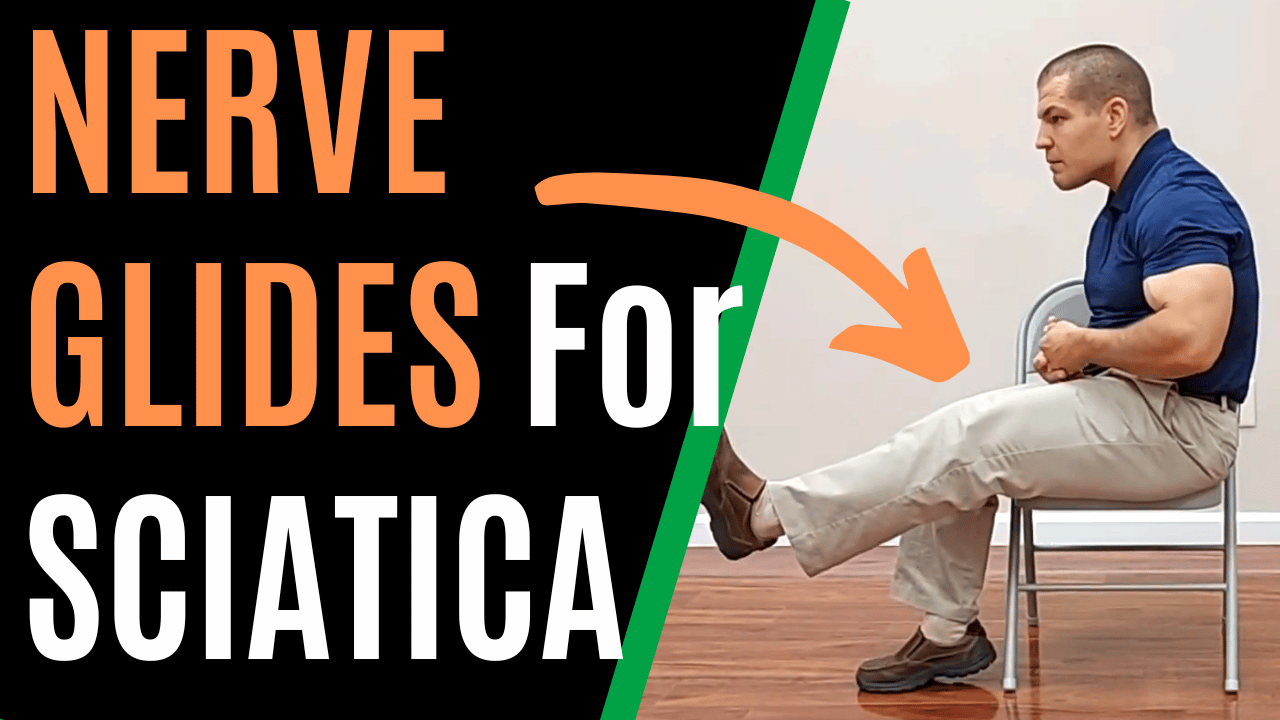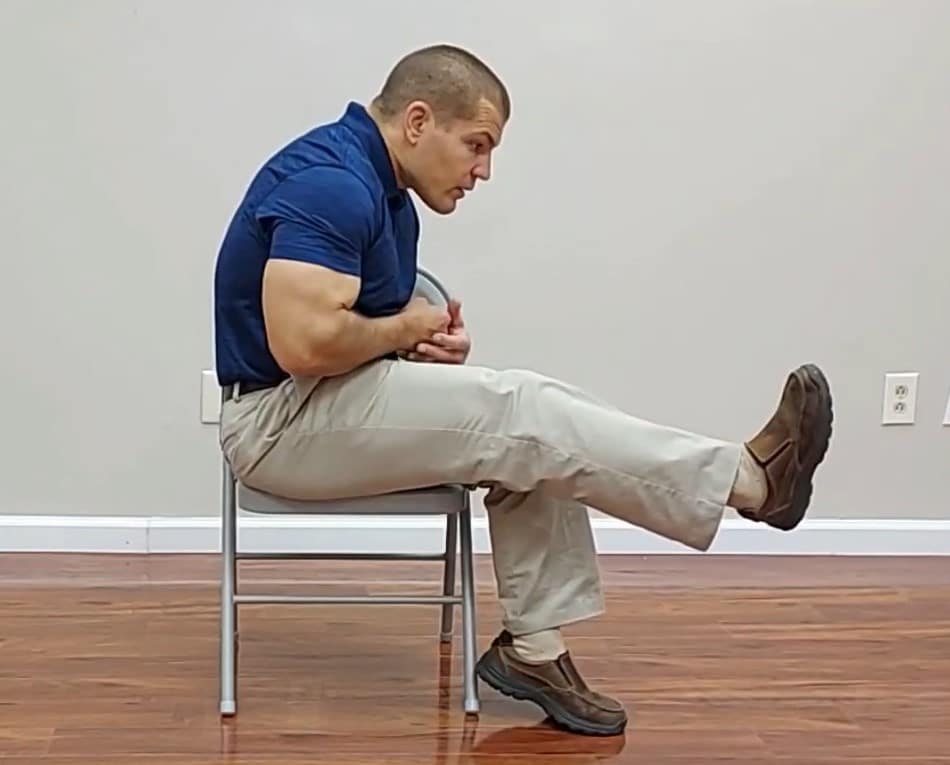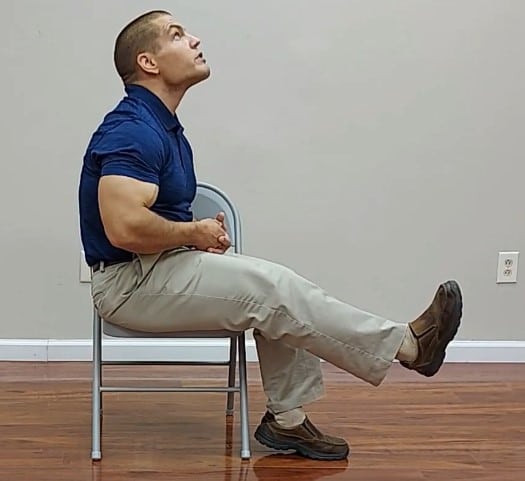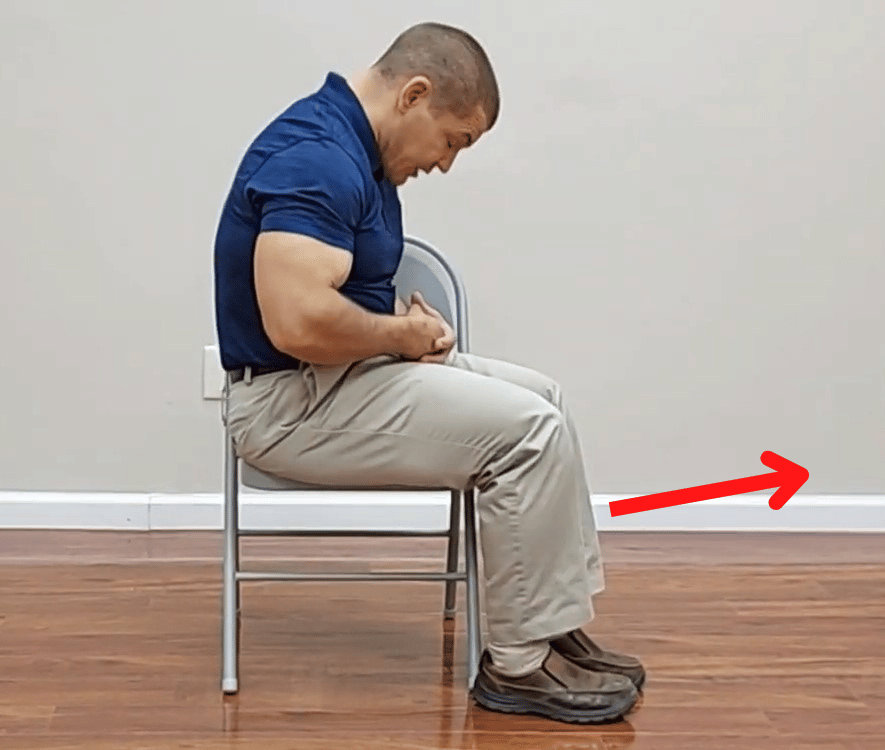Nerve Glides Are A Common Treatment For Sciatica, But They're Not Good For Everyone With Sciatica
Watch the video to learn how to do nerve glides for sciatica, plus when you should and should not do them
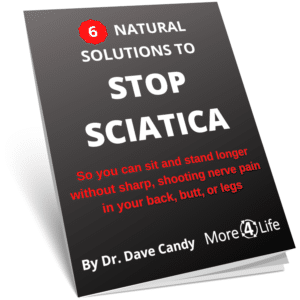
What Are Nerve Glides For Sciatica?
Nerve Gliding (aka nerve flossing) is a type of exercise that can be used to treat peripheral nerve problems in either the arms and/or legs. This post will focus on nerve glides for sciatica, but nerve glides can be used to treat other nerves as well.
Nerves need 3 things to be healthy:
- Space - they can't be pinched or compressed
- Movement - to allow the nerves to move through the tissues around them as you move your body
- Blood flow - to bring glucose and oxygen to the nerves
Nerve glides effectively focus on the latter two of these. They move the nerves, and by moving the nerves, you increase local circulation (blood flow) to the nerves.
Your Nervous System Is Interconnected
Your nerves are continuous run from your brain, to your spinal cord to your limbs. They are continuous electrically and chemically, and the connective tissue sheaths around the nerves are continuous.
Therefore, problems in one part of the nervous system can affect the ENTIRE system.
Nerve glides get your nerves moving back and forth between the continuous connective tissues (meninges and perineurium) and help with diffusion of chemicals within the nervous system.
But What About Nerve Glides For Sciatica?
Your sciatic nerve is made up from the L4, L5, S1, S2, and S3 nerve roots and then continues through your buttock and down the back of your leg.
Sciatica can result from irritation, compression, or adhesion anywhere along this pathway.
That's why sciatica is a symptom, not a diagnosis.
The term sciatica means nothing more than "pain in your back, buttock, and/or leg" . It doesn't really tell where that symptom is coming from, what caused it in the first place, or how to get it to go away.
Nerve Glides For Sciatica Are A General Treatment
The GOOD part about nerve glides for sciatica are that they aren't specific to the cause. They affect the entire pathway of the sciatica nerve from the brain down to your toes.
The BAD part about sciatic nerve glides is that they aren't specific to the cause.
We'll get more to that second part later.
But first:
Why Do Nerve Glides For Sciatica?
As mentioned before, the sciatic nerve runs from the nerve roots in your lower back down to your toes.
As it travels along that pathway, it passes through a lot of joints, connective tissue, and muscles. Any of these structures can apply pressure to the sciatic nerve or the connective tissues around it, thus limiting nerve mobility and blood flow.
Nerve glides focus on moving a nerve back and forth through the body tissues around it, kind of like moving dental floss back and forth through your teeth. That's why nerve gliding is sometimes also referred to as "nerve flossing".
Symptoms Of A Pinched Or Compressed Nerve Include:
- numbness and tingling
- weakness in the areas the nerve innervates
Notice, that PAIN is NOT a symptom of a compressed nerve. Nerve fibers themselves don't have nociceptors - free nerve endings that produce pain-provoking signals.
PAIN is more of an indication that there’s inflammation of the connective tissue sheath that runs around that nerve. But fortunately, nerve glides also help treat the tissues around the nerves.
How To Do Nerve Glides For Sciatica
There are two different types of nerve glides
- Sliders / Gliders
- Tensioners
Sciatic Nerve Sliders / Gliders
The first kind of nerve glide for sciatica is called a slider or a glider. In this type of nerve glide, the nerve does not change length.
Again, think of the analogy of "nerve flossing". When you're flossing your teeth, the you hold the piece of dental floss tight and move it back and forth without stretching or relaxing the piece of floss.
Nerve flossing using the slider / glider method is good for more irritable nerve conditions.
Unlike your muscles, your nerves aren’t really made to stretch. If you have a very sensitive case of sciatica sciatica, then nerve slider / gliders will be a better, less aggressive option for you.
Sciatic Nerve Tensioners
The other kind of nerve glide for sciatica is called a tensioner, which is more aggressive than the slider / glider method.
During this type of nerve glide, you actually lengthen the nerve a little bit.
Or, at least you lengthen the connective tissues around the nerve.
You need to be able to put your sciatic nerve under tension, for example, when bending down to pick something up off the floor.
Tensioners help get your nerves more ready for the everyday demands that will be placed on them. However, for people who have highly irritable conditions, tensioners are more likely to cause a flare-up.
You should definitely avoid sciatic nerve tensioners if:
- Your sciatica symptoms are highly irritable.
- You get flare ups easily or they last a long time after you do get one.
- You have a pinched nerve, and the tensioner makes your numbness or tingling get worse
Need Help For Sciatica?
Tap the button below to request an appointment with one of our specialists.
How To Do A Slider Nerve Glide For Sciatica
Slider nerve glides have the goal of "flossing" the sciatic nerve back and forth through the tissues that it runs through without changing it's length.
During a slider / glider you put tension on one end of the nerve, while releasing the tension on the other end of the nerve. The net effect of this is that the nerve slides back and forth through the tissues around it without changing length.
The image below shows a position where your sciatic nerve is at near maximum tension.
Note that the leg leg is fully extended, toes pulled upward, and neck and back rounded forwards.
However, the point of a slider exercise is to just slide the nerve back and forth, and not stretch it. In order to release the tension on one end of the sciatic nerve, you can simply lift your head up, as shown below.
The other end of the sciatic nerve is still being tensioned, as the leg is extended, and the back is rounded.
To do a slider / glider nerve glide go back and forth from the picture above, to the picture below
- Starting position: head down, knee bent (see picture below)
- Ending position: leg fully extended, and your neck tilted backwards (see picture above)
Switching between the two positions shifts the nerve’s tension from your head being tilted downward, to your leg being extended in the other position, while the other is always un-tensioned.
How To Do A Tensioner Nerve Glide For Sciatica
On the other hand, sciatic nerve tensioners or put the sciatic nerve on stretch (or under tension).
Remember when we looked at the position where there's the most tension on the sciatic nerve? Well, tensioner Nerve Glides, as shown below, are very similar to this position.
With a tensioner, the first thing you can do is slowly add tension to both ends of the sciatic nerve.
Do this by starting in a resting position, as shown below, where your head is leaned backward and your leg is bent. Then, transition into the fully extended position shown above, with your head leaning forward, and your leg extended.
Another method of starting off the tensioner nerve glide is by starting the movement with your head pulled forward, tensioning one end of the nerve, and then slowly extending your leg into the fully extended position.
This tensions the other side of the nerve, and stretches it as a tensioner should. The starting position can be see below:
How To Know If Your Should Do Nerve Glides For Sciatica
Nerve glides can be helpful for most people with sciatica, as long as they don't worsen your symptoms.
Whether you're doing a slider or a tensioner nerve glide if you experience increased pain doing them, you're probably going too far.
More Is Not Better When It Comes To Nerve Glides
Nerve glides are NOT a "no pain, no gain" type of treatment.
After all, the goal of this movement is to help you feel better, and if doing these movements makes you feel worse, you should back off on the range of motion.
If that doesn't work, stop completely.
Not only do nerve glides treat the peripheral nerves, but they also treat the central nervous system - your brain.
Sciatic Nerve Glides Affect Your Brain?
Part of the goal of nerve glide is to create pain free movement experiences - or at least, not worsen the pain you already have.
By experiencing movements that move or tension your nerves without worsening your pain, your brain actually starts to have less fear about movements that require tension your nerves such as bending forwards from standing.
When Should You NOT Do Nerve Glides For Sciatica?
If you recall from earlier, nerves need 3 things to be healthy:
- Space to move
- Movement
- Blood flow
Nerve glides address the movement and blood flow of nerves, but if the nerve is being pinched, compressed, or adhered by some other structure, then the nerve won't be able to glide. It will just get stretched.
Some of the structures that can stop the sciatica nerve from gliding properly include:
If you remember I mentioned earlier:
The BAD part about sciatic nerve glides is that they aren't specific to the cause of your sciatica.
Sciatic nerve glides are sort of a "shotgun" approach to treating sciatica.
Move the nerve and hope it gets better... and a lot of times it does.
That's why nerve glides are such a common physical therapy treatment for sciatica. Because they're a general approach that works in a lot of cases.
But what do you do if nerve glides DON'T help your sciatica?
You need to find out the CAUSE of your sciatica.
(Remember, sciatica is a symptom, not a diagnosis)
What structure, or more often structures (plural), are irritating the sciatic nerve?
Is it the nerve itself, the nerve roots, or the connective tissue around the nerve
Or is it all of them?
What caused those structures to start hurting in the first place?
(a.k.a. What's the cause of the cause?)
Want To Discover The Root Cause Of Your Sciatica?
Request a Sciatica Discovery Visit with one of our specialists to discover how we can help.

